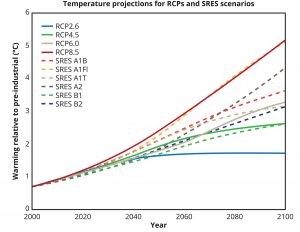Integrating accurate weather and climate data into BIM can cut costs for construction projects in the planning and development stage, as well as mitigating the longer-term climate challenges of tomorrow
For years, weather data has been used in the construction industry; historical data to support contractual claims for extensions of time or forecast data for a broad overview of upcoming conditions. The Met Office has over 40 years’ experience in the construction sector and works closely with businesses at all stages in the production lifecycle, consulting on ways of mitigating the most impactful weather scenarios.
It is common to hear about construction projects being prone to delays and going over budget – for example, the Queensferry Crossing, which opened successfully in August 2017, was six months later than originally planned due, in part, to the loss of 25 days to high winds in April and May 2016. But what if such large overruns could become a thing of the past or, at least as far as weather and climate are concerned, significantly mitigated? And what about improving a project’s long-term resilience and reducing its impact on the climate over time?
In the planning phase, the importance of site suitability and an understanding of the weather and climate challenges that may be faced during construction and throughout its life are of paramount importance.
In the longer term, whether or not a project can withstand the weather needs of today and the climate challenges of tomorrow can be accurately considered through the early interpolation of climate and weather data, which can literally save hundreds of thousands of pounds.
What the weather is likely to do over the lifecycle of your project is not crystal ball gazing: World-leading supercomputer capability underpins Met Office weather forecasts and climate information, giving construction professionals access to vast amounts of data and reports, which enables them to mitigate the risks posed by an increasingly variable climate.
Design
It is fair to assume that only a small fraction of design teams considers the weather in relation to commissioned work, the obvious exceptions being those faced with sites that are clearly exposed to the elements. However, sites that may seem low risk to weather effects now may not necessarily be so in 20 to 30 years’ time.
There is perhaps a lack of awareness of the availability of weather and climate data which makes it easy to overlook. For example, this International Panel on Climate Change graph (above) illustrates the various climate warming scenarios we could see in the next 80 years (click on the image for full details). The data that sits behind each potential scenario can be used by planners and modellers to test a project’s resilience against the potential conditions that might be faced in the future. The UK’s climate projections can be found on the Met Office UKCP18 Website. The headline effects for the UK are that sea-level rise will occur for all emission scenarios and at all locations around the UK beyond year 2100, and there may be changes in rainfall and temperature extremes which will affect all areas of the UK.
BIM and Geographic Information Systems (GIS)
The early use of weather and climate data is best demonstrated in Norway, where site exterior works and drainage plus the weather data to test these works, have to be loaded into GIS models at the same time as a building is modelled, so that a thorough understanding is gained of site suitability and the context of the building’s relationship to its local environment.
As well as climate change scenarios looking deep into the future, it is also just as important to look into the recent past to understand what conditions might be experienced on site. There are a number of Met Office data sets available that can assist at the planning stage such as: soil moisture and runoff; historic rainfall analysis; detailed height-specific wind models; atmospheric dispersion event modelling (such as nuclear accidents, volcanic eruptions, chemical accidents, smoke from fires, odours, airborne animal diseases), as well as the provision of routine air quality forecasts; and more general location-based planning average reports with 11 standard weather parameters (rainfall, temperature, wind speed etc) to assist in deciding realistic project deadlines prior to build.
BIM to smart buildings
The UK has legislated for net zero emissions by 2050 and UK infrastructure has a big part to play in this reduction. Weather and climate data can be especially useful in developing smarter smart buildings; for example, there is no reason why weather cannot assist the industry in taking steps to protect people from the dangerous effects of overheating or take positive steps to reduce, reuse and recycle water.
This data can also help in the running of a building, helping it to mitigate its energy use and carbon footprint. If a BIM model were loaded with forecasts, this data could not only test the climatic behaviour of the building when testing insulation values and specifying air tightness, but also be used to predict seasonal energy requirements. As on-building solar power becomes more prevalent, weather data could be used to enable building systems to anticipate the quantity of insolation to expect which, in turn, helps plan daily system behaviour, gathering power and heat, and deploying shade as expected.
Summary
The early adoption of meteorological reports and data allows weather and climate-related risks associated with a project to be considered, understood and modelled, leading to huge potential cost savings across the whole project lifecycle. There are other benefits too: improvements to the local population and building users’ physical and mental health through increased green infrastructure; more resilient homes with excellent indoor environmental quality; and lower energy bills, to name just a few.
In future articles, we will look at the subsequent stages of the construction lifecycle, providing a 360-degree view of how the early incorporation of Met Office data can deliver benefits at every stage.
For further information, email construction@metoffice.gov.uk or call 0370 900 0100.
Tel: 0370 900 0100
Please note: this is a commercial profile.


















